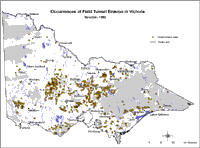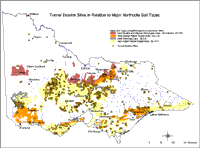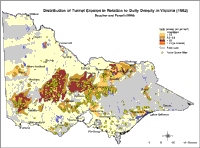Distribution of Tunnel Erosion in Victoria
Tunnel Erosion Home | Tunnel Initiation & Development | Reclamation of Tunnelled Land | Conclusions | References
Jenkin (1986, 136) noted that the southeastern uplands of Australia contain a `... widespread array of landscapes sensitive to suddenly imposed stresses' on which sodic duplex soils are found. Furthermore, he suggested that sheet, tunnel and gully erosion were probably extensive in the 1840s and 1850s when associated with those soil characteristics and soft alluvial sediments. Some of the environmental changes wrought by European settlement which would have affected tunnel initiation directly and/or indirectly resulted from deforestation which was undertaken for various purposes including housing, fuel, furniture, props for mining as well as to encourage the growth of native pastures. In addition, the destructive effects of overgrazing by stock and rabbits, mining activities and the use of fire may have been compounded by periods of drought, so that a decline in pasture cover exposed sodic duplex soils to the often unpredictable nature of semi-arid climates (Downes, 1946; 1958; Boucher and Powell, 1994). Tunnelling was observed prior to 1900 near Costerfield (W.M. Fogarty, pers.comm.) and after the 1914 drought in northeastern Victoria (Downes, 1946).
| Leeper (1955) noted that not only was tunnelling peculiar to Victoria, it was the most widespread type of water erosion in the State and more strongly influenced by soil properties than climates. Generally speaking, it appears that observations of tunnel erosion in Victoria have been made on private land, although there are insufficient staff trained to identify the problem in large areas of public land (Creek, 1988). As the mechanisms of tunnel initiation are not well understood, reclamation measures have not always been successful (Boucher, 1990) and, therefore, the sites marked may still reflect potential tunnelling hazards. The data were compiled from District Soil Conservation Competition Reports (1940-1985) and various other publications and updated by officers of the Department of Conservation and Environment. On a map of soil erosion in Victoria produced in 1944, tunnelling was noted in the Parwan Valley and near Seymour, Stawell, Violet Town and Wallan. Boucher (1990) noted that tunnel erosion has mainly been found on cleared woodland-covered hills as well as sites located along forest-woodland boundaries in the Otways, the Eastern Highlands and Gippsland. The relatively flat areas of the Mallee have also occasionally been affected. |
| This scanned map of soil types as they relate to sodic soil classes was derived from the 1:2 000 000 `Soil map of Victoria' (Anon., 1964) which, in turn, was based on the `Atlas of Australian Soils' (Northcote, 1960-1962) and further simplified by Ford et al. (1993). The map scale meant that small areas of other soils in these broad groups and variations within toposequences were excluded and there was a lack of suitable data to include saline sodic soils. Approximately 82 % of tunnelling has occurred on duplex soils (mainly Sodosols and Chromosols) with 62 % of the total number of observations being correlated with the acidic yellow duplex (i.e. Dy 3.41) type, which occupies almost 2 Mha of agricultural land and includes just over 20 % of land under cover of pasture. The cracking clays (Vertosols) in southwestern Victoria are also sodic and the upper slopes are affected by tunnel and gully erosion as well as landslips (N.S. Badawy, pers. comm.). |
Tunnel incidence associated with the main sodic soil classes in Victoria
Dominant Soilsa | Sodicity Classb | Tunnel Incidence (%) |
Dy 3.41 | Acidic | 62.4 |
Dy 3.42 | Neutral | 8.9 |
Dr 2.32 ; Dr 2.33 | Neutral; Alkaline | 10.9 |
Ug 5.1 | Alkaline | 3.2 |
All others | Various | 14.6 |
| Legend a based on Northcote (1979). b Classification of Rengasamy and Olsson (1991). |
| This scanned map of tunnel and gully erosion is taken from the data published in Boucher (1990) and Sargeant (1983), the latter published in Ford et al. (1993). Information on gully erosion was derived from aerial photographs and field inspection by Milton in the 1970s, and adjusted by Sargeant in 1983 (I.J. Sargeant, pers. comm.). `Gully density' was assessed on the basis of gully length (km) per unit area (km2). Tunnel erosion is frequently grouped with gullying, but the processes, mechanisms, and resulting landforms involved are quite distinct (e.g. Milton, 1971). The patterns of these two types of erosion are clearly similar throughout much of the State (Boucher and Powell, 1994). From the above series of maps it is apparent that tunnel and gully erosion were usually found on cleared uplands associated with erodible sodic duplex soils in areas receiving a mean annual rainfall of at least 500 mm. |





